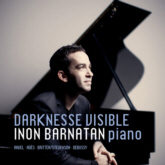The three pieces of Ravel's "Gaspard de la Nuit" (which roughly translates as "Treasurer of the Night") take their titles from poems by Aloysius Bertrand. In this pathbreaking 1908 score Ravel explored new dimensions of sound and technique on the piano. There are fiendishly difficult challenges, especially in the concluding "Scarbo," about a gnome who stalks the sleep of the narrator.
Many fine pianists have performed "Gaspard" dazzlingly, as does Mr. Barnatan. But I have rarely heard the piece played with such rhythmic and textural clarity. Mr. Barnatan's slightly cool approach makes the music even more demonic. The pianist has collaborated with the artist Tristan Cook on videos of "Gaspard" that have found an audience on YouTube, including an especially engrossing "Scarbo."
Mr. Barnatan, who was born in Israel in 1979, had extensive training in London and now lives in a converted warehouse in Harlem, is also impressive in another Ravel tour de force, "La Valse." This eerie evocation of a waltz begins amid misty colors and evolves into something maniacal. Mr. Barnatan brings tenderness, lush colors and crisp Neo-Classical touches to Debussy's "Suite Bergamasque." An intriguing novelty is the English composer Ronald Stevenson's episodic and inventive 1971 fantasy on music from Britten's opera "Peter Grimes."
Thomas Adès's "Darknesse Visible," the composer's deconstruction of a song by John Dowland, has become a calling card in Mr. Barnatan's recitals. Without changing a note, Mr. Adès reduces the song to slow motion, prolongs and repeats pitches, puts harmonies through displacements of register and reveals the musical ghost within. Mr. Barnatan's playing is both delicate and haunting.

 Back to List
Back to List